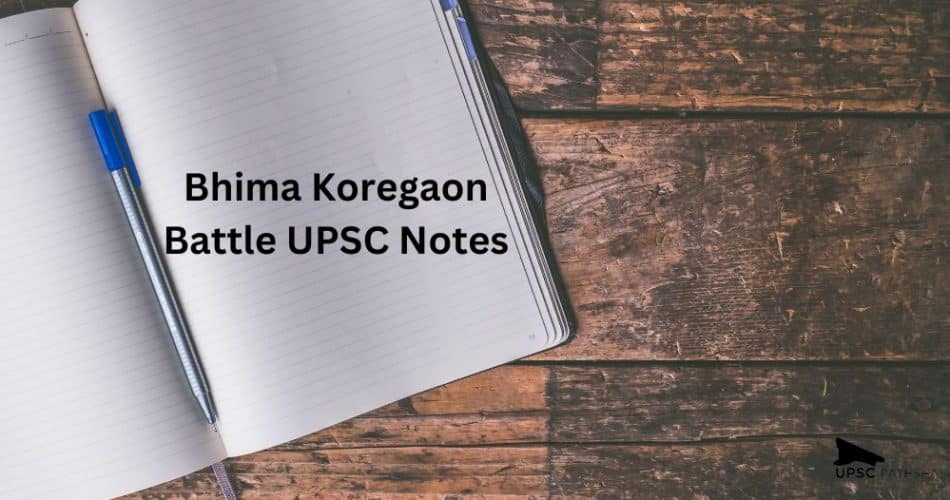Bhima Koregaon Battle UPSC is covered in this article. You should follow the article to acknowledge the best course for UPSC for your civil service preparation. Let’s go through the article now!
Also Read: UPSC Calendar 2023: Must know Things about Civil Service Exam
Bhima Koregaon Battle UPSC
Bhima Koregaon is a small village located in the present-day Pune District of Maharashtra. This battle which happened in Koregaon has an important place in the history. It is considered quite significant in India. The date of the Battle of Bhima Koregaon is 1st January 1818. The Battle of Bhima Koregaon was fought between the Peshwa body of the Maratha coalition and the British East India Company. This was a large battle which was part of the Third Anglo-Maratha War.
Third Anglo Maratha War resulted in the defeat of the Peshwas which led to the rule of the British East India Company in nearly all corridors of South, Central and Western India. Also, you should know that Peshwa Baji Rao II led the army of Peshwas. This was done in the Battle of Bhima- Koregaon.
The Marathas had a strong force. The Maratha army had army officers and cavalry officers. The other important leaders who led the Marathas in the Battle of Bhima- Koregaon were Bapu Gokhale, Appa Desai, and Trimbakji Dengle. Captain FrancisF. Staunton led the British East India company.
Civil Service Exam Preparation
The British East India company had around 800 officers. There were 500 armies and 300 cavalry dogfaces. Also, the British East India Company had 24 artillery cannons to fight in the battle. The Maratha army was led by Peshwa Baji Rao II. It was on their way to attack the position of the British East India Company. This was subjected to Pune.
On the way, this army of Marathas was challenged by 800 dogfaces led by Captain FrancisF. The British East India Company successfully defended and the colors of Peshwa ended up withdrawing from the battle. In the contemporary estate-predicated society, the Mahars were considered untouchable.
The Battle of Bhima Koregaon attained a fabulous status among the slated gentries of India. The people of the slated estate saw this battle as a win for Dalits over the oppression of the people from advanced estates. In Koregaon, the British East India Company installed a gravestone or Palm Pillar to commemorate those who fought for them. Dalits believed that this was a win of the Mahar community against the estate shafts executed by the Peshwas.
Also Read: How to Choose the Right Test Series to Ace the UPSC Exam?
UPSC Notes
On 1st January 1927, Dr. B.R. Ambedkar visited the Koregaon Victory Pillar. You should acknowledge that thousands of his followers visit the site to commemorate the visit of Dr. B.R. Ambedkar on every New Year. The win was seen as a palm against estate-predicated demarcation and oppression. Also, grab the fact that the Peshwas were notorious. They were so for their oppression and persecution of Mahar Dalits.
The palm in the battle over Peshwas gave Dalits a moral palm against the estate- predicated discrimination and oppression and a sense of identity. Still, the peak and rule policy of the British created multiple crevices in Indian society which is indeed a visible moment in the way of devilish estate and religious discrimination. This was due to the needs to be reviewed as per the Constitution. Back in the seventeenth century, the community was particularly valued by the sovereign Shivaji, under whom Maratha estate individualities were far more fluid.
The value of the Mahars for military recovery under Shivaji was noted by the social leftist Jyotirao Phule. The Mahars were not only heirs of the attempt at estate concinnity under Shivaji but were in fact valued for their martial chops, frippery, and fidelity.
Prepare for the UPSC Exam
The position enthralled by the Mahars under Shivaji, still, was short-lived and after Peshwa autocrats, their status deteriorated. The Peshwas were ignominious for their Brahmin fallacy and their persecution of the rejects. The Mahars were interdicted to moving about in public spaces and punished atrociously for disrespecting estate regulations.
Stories of Peshwa atrocities against the Mahars suggest that they were made to tie brooms behind their tails to wipe out their vestiges and pots on their necks to collect their spit. The battle has come to be seen as a symbol of Dalit pride because numerous officers in the Company forces were Mahar Dalits. Since the Peshwas, who were Brahmins, were seen as tyrants of Dalits, the win of the Mahar officers over the Peshwa force is seen as a Dalit assertion.
On 1 January 1927, B.R. Ambedkar visited the memorial gravestone erected on the spot which bears the names of the dead including nearly two dozen Mahar dogfaces. The men who fought in the battle of Koregaon were the Mahars, and the Mahars are Rejects.
Also Read: Self-Preparation Strategy for UPSC: How to Start Preparing for IAS?
Conclusion
Therefore, visit the UPSC Pathshala website for your preparation and find the best course for UPSC.







